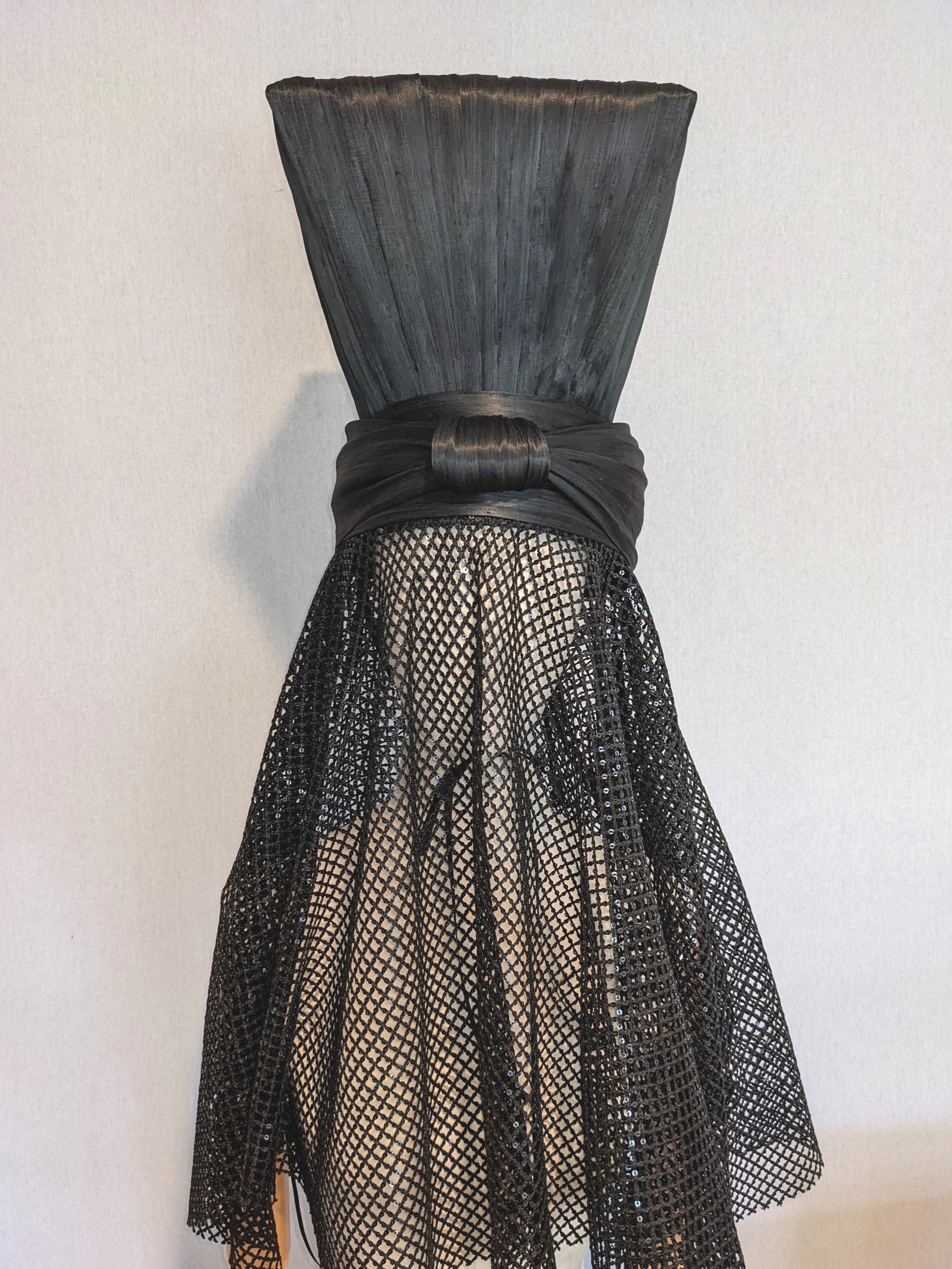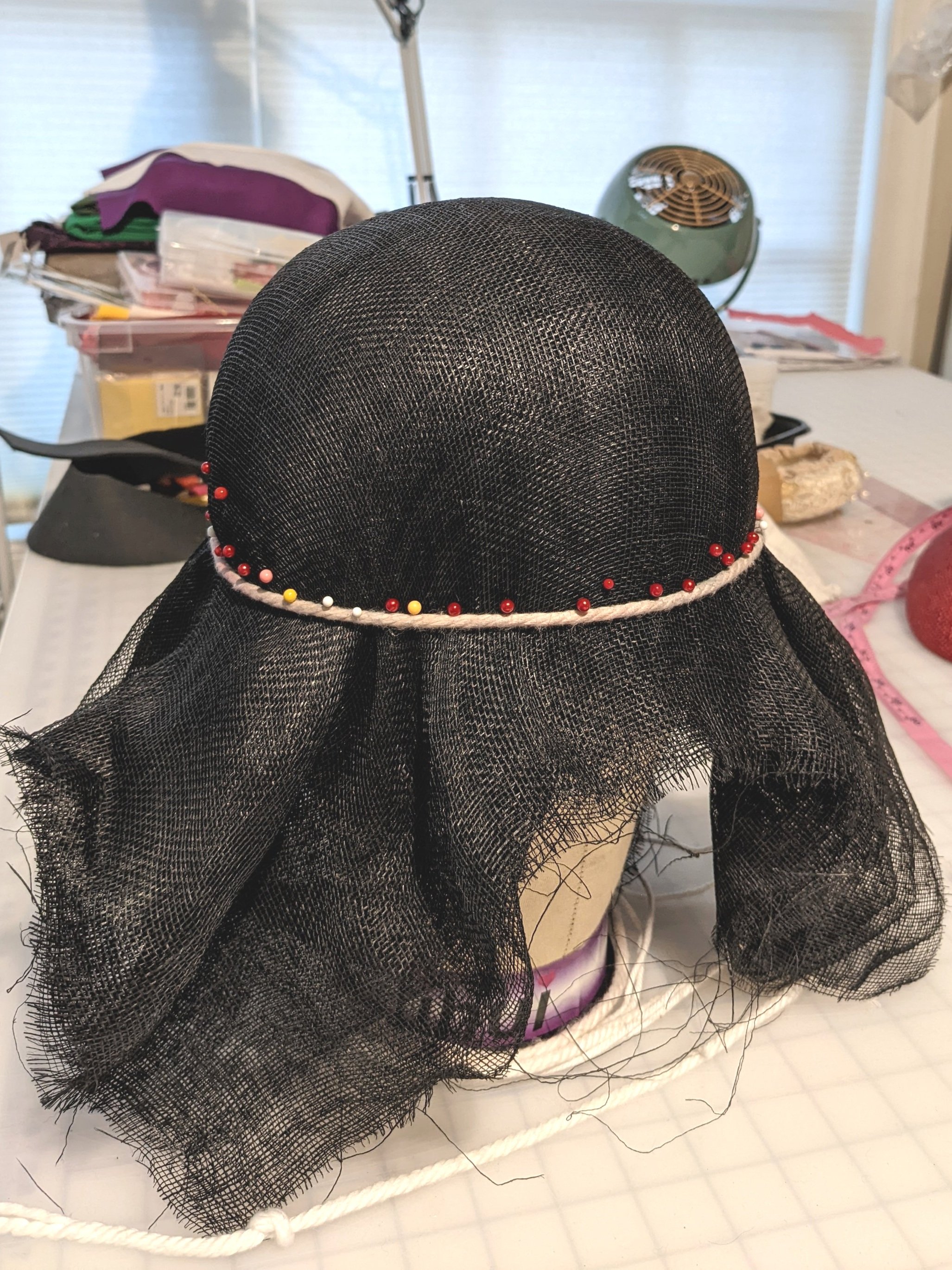Reverend Mother Gaius Helen Mohiam
My most interesting commission this year so far was recreating the hat worn by the Reverend Mother Gaius Helen Mohiam in HBO’s 2021 version of Dune. It was my first cosplay commission, and hopefully not my last. Doing interesting and challenging work is the most rewarding.
On the surface, the hat looked pretty straight forward. Then I began to pick apart the costume after studying it online. My first idea was to recreate the hat exactly as I saw it. It had a beaded veil, and what looked like a light cotton black and white printed fabric. I think cotton or chiffon because of the pleats. After a couple of days of analysis, I stepped back from the project and imagined what this should look like walking around in a well lit location, possibly in daylight. If I replicated the head piece, it would look like a dress was draped on top of a Nefertiti-shaped crown. When I considered the make-up, lighting, and special effects that were added to create this somber character, a draped floral piece wasn’t going to cut it. I wanted my client to look like he just walked off the screen of the light-challenged room, bringing with him, the lighting and special effects. With that objective in mind, recreating or should I say re-interpreting the Reverend Mother’s costume into a real fantasy piece became my objective. It’s all about bringing the fantasy to life, not a straight replication.
Once I jumped over this hurdle, I was able to begin sourcing materials. The veil was the most challenging. Without getting overly detailed about replicating the beaded piece, which was not available unless I made it myself, I narrowed it down to the open weave, weight, and drape of the fabric. It was like Goldilock’s and the Three Bears: the first was too heavy, the second was too light, and the third was just right (not exact) but perfect for the overall effect.
The main crown and turban base was made from Albaca silk straw. It took a full two yards to create the pleated effect. But the under pinnings and crown base were all made using standard millinery techniques. I really leaned in on my knowledge of hat foundations and wire engineering to develop the overall shape. My client had a larger head, and it required padding a dolly head with felt to give me the extra large size (his head was 24.25 inches). I wasn’t great about taking pictures of all the steps. I did my best to remember. See my steps below.
I used a wig dolly with a close head size to block the crown base using five layers of stiffened sinamay straw, and then stiffened a second time after blocking but before removing it off the base. When using a lighter weave straw, more layers is better. It takes practice to get up to five layers without a wrinkle.
Once the base was ready, I began shaping the crown using millinery wire. The edge of the base was wired and covered with Petersham at first (which you see here), but then I changed it to sinamay bias binding to give it a stronger bind and support.
This was my first wire attempt, which ended up being shorter and narrower than the final attempt. It’s one of those things where the picture tripped me up, when I should have created the crown proportioned to the base. With such a large base, it wanted a bit more drama than I was giving it.
Here is the crown stabilized with buckram after I was happy with the shape. I attached the veiling on top of the crown after I added a custom head band for support.
A quick but important note about the veiling. I cut a circle which means I was working with the fabric bias. I had to hang this fabric before doing the final cut so it wouldn’t lose its shape later. It’s a trick I learned when I sew clothing on the bias. Sewing off grain without letting fabric rest in the bias might shift the dress later. I positioned the veiling so it was a smidge shorter in the front, so the sides would drape nicely like a wedding veil. I tried it even all around, but in the end it felt most pleasing this way to me.
Just enough interlining for covering the buckram.
I nearly skipped this step, only because I did not think I needed it. But I had a dream the night before telling me to pad the buckram before draping and pleating the Albaca silk straw. It was the best decision I made. Adding an interlayer of lamb’s wool created a beautiful cushion for the straw. Interlining is a technique that tailor’s use on clothing to add padding between jackets and coats. It provides a warmer layer, but it is also used to create a nice buffer between the outer fabric and inner lining. I use this interlining technique often in other millinery work. I had just enough of the black lamb’s wool on hand to cover this extra large crown. It had a height of 12 inches at the highest point in the back.
I began pleating the top of the crown and wrapping the edges inside the base from front to back, and then repeated the pleating steps from left to right. I did this step twice because the straw was fidgety.
Once the crown was done, it took me ages to attach it to the base. It must of taken me ten tries to stitch it as centered as humanly possible. One of the things about working with natural materials is all the imperfections and thickness variations in the fiber. I had to lean into the natural fibers while trying to be as precise as possible. When the crown was attached, I created turban pieces for the base. This was also tricky because the veiling made stitching the final turban section challenging.
Look how smooth the pleated base looked after it was finished. I owe this professional finish to the interlining.
As a reference point, here is the side view of the headpiece from the Dune 2021 movie. I think mine looks pretty close. But remember, it was based on the circumference and size of my clients head. From the angle this photo was taken, including the lack of lighting, you might think this hat was mostly black. The veiling on my piece had some sequins, and it gives it a theatrical sheen—like he just stepped out of the movie.
Here is a horrible selfie, demonstrating the extra ties I built in to secure the hat. The veil is long and weighty enough to drape on top of the crown, but there is another ribbon that can be used to tie the veil back for breathing, talking and eating purposes. At the end of the day, this hat has to remain wearable. Unlike the movie costumes, practicality might not be necessary.
Engineering should not be taken lightly. I had to think about all the practical things along the way. How to hold up the veil, how to keep the hat secure on the head, how to keep the whole piece light enough to wear. None of these things are important when filming a movie on a fake set. Creating this piece began once I found the Spirit and aesthetics of the hat. Just like giving birth to a newborn baby, once that special Spirit is found, then the structure and shape can take place. I hope you enjoyed my little journey into this fantasy piece.










